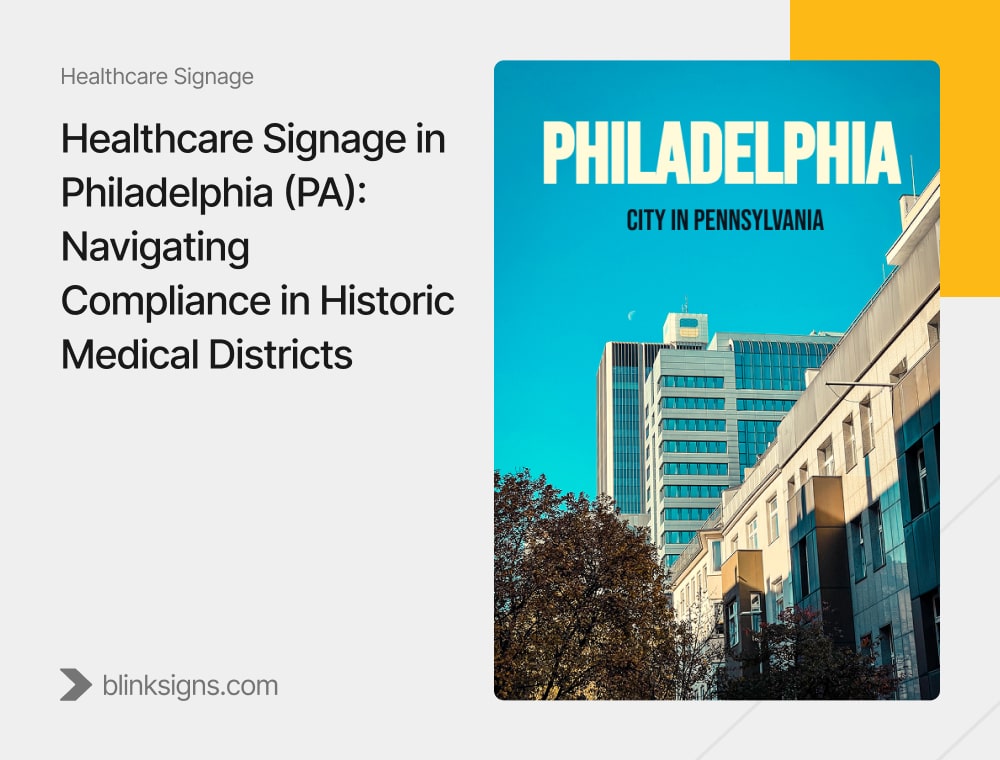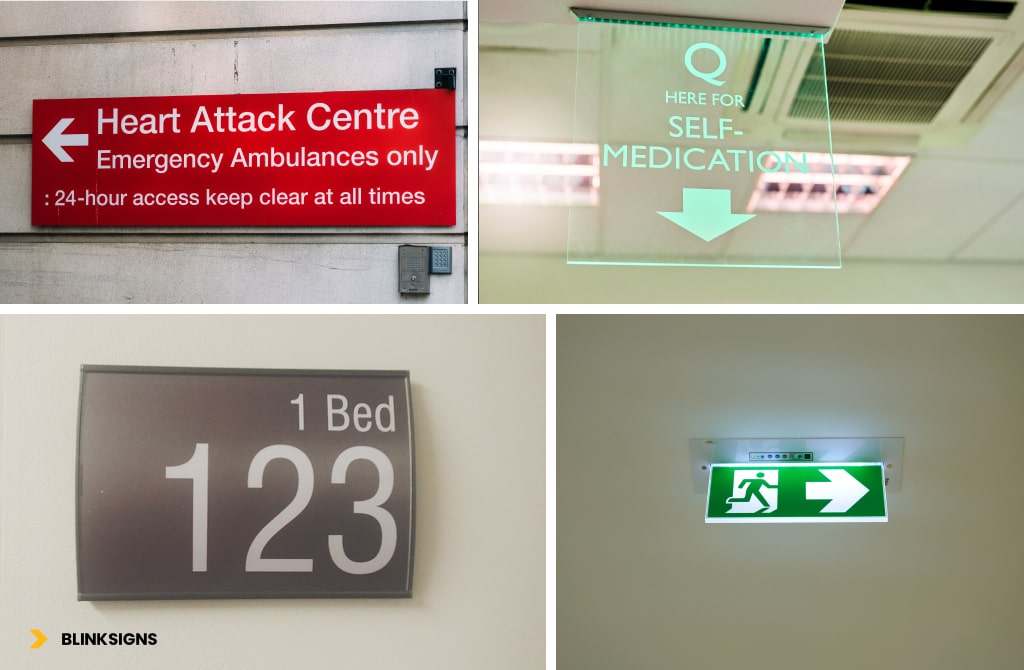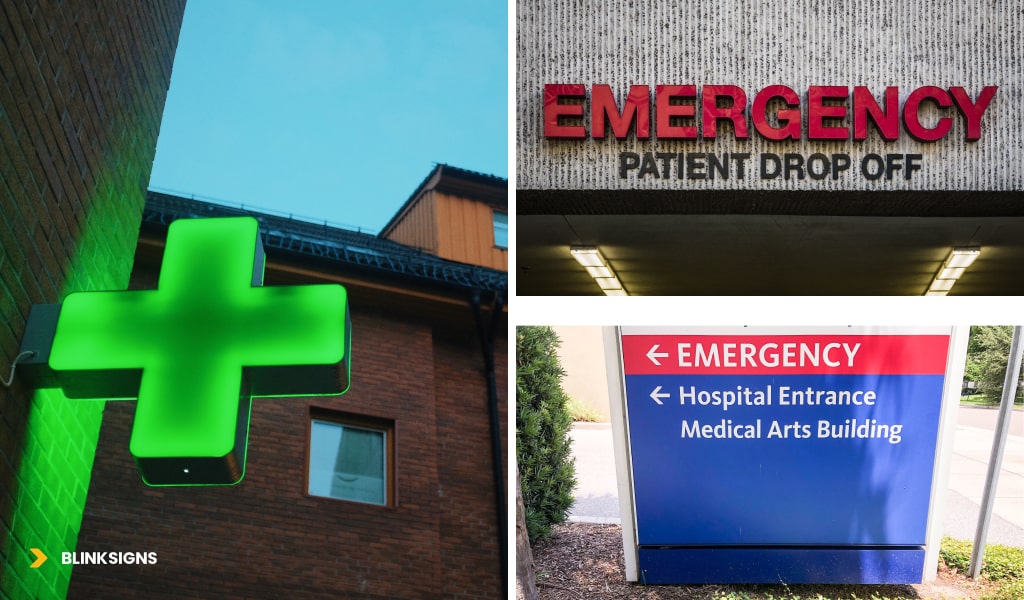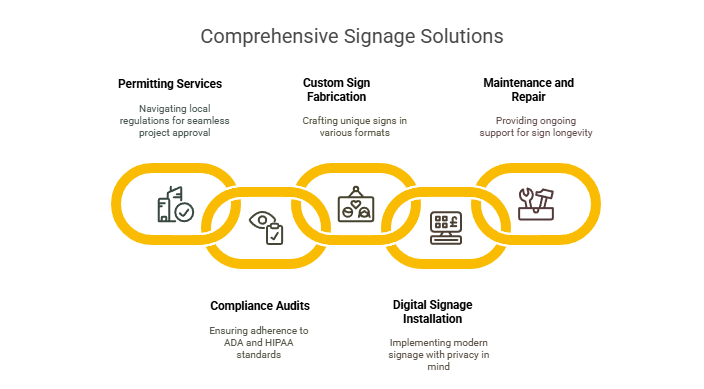
Healthcare Signage in Philadelphia (PA): Navigating Compliance in Historic Medical Districts
In a city like Philadelphia, healthcare signage does more than guide—it protects, informs, and comforts. As one of the oldest and most medically advanced cities in the U.S., Philadelphia’s hospitals, outpatient centers, and research facilities are often woven into historic neighborhoods, where compliance, accessibility, and design constraints intersect.
From University City’s sprawling medical campuses to Center City’s urban clinics, institutions face a unique challenge: delivering a seamless patient experience while adhering to ADA guidelines and HIPAA regulations, local zoning codes, and historic preservation requirements. For patients navigating multi-building complexes or non-English speakers trying to reach a department in an emergency, signage isn’t a luxury—it’s a critical infrastructure.
At BlinkSigns, we understand that healthcare signage in Philadelphia must blend precision, sensitivity, and strategic compliance. That’s why our systems are designed to meet federal mandates while honoring the visual and regulatory character of the city’s healthcare districts.
Navigating Compliance: ADA, HIPAA & Philadelphia-Specific Codes
Healthcare signage isn’t just a branding concern—it’s a legal one. In Philadelphia, compliance begins with understanding a multi-layered framework of federal, state, and local requirements.
ADA Standards mandate that all public-facing healthcare signage, including room numbers, restrooms, elevators, and directional signs, be accessible to people with disabilities. This includes specifications for Braille, font legibility, contrast, height placement, and tactile materials.
HIPAA Compliance, on the other hand, affects how digital screens, waiting room signage, and patient check-in kiosks are displayed. Protected health information must not be visible or audible to unintended recipients, meaning sign placement and visibility zones matter.
Adding complexity, the Philadelphia Department of Licenses & Inspections (L&I) enforces regulations on sign height, illumination, placement, and material usage—especially in historic zones like Old City and University City. Facilities may face additional review boards if their building is considered architecturally protected.
At BlinkSigns, we navigate this for you—our team handles sign permitting, compliance audits, and regulatory documentation directly with L&I, so your focus remains on patient care.
Interior Signage Systems: Elevating the Patient Experience

Interior Signage Systems_ Elevating the Patient Experience
Inside hospitals, the environment can feel overwhelming. Patients and visitors may be anxious, in pain, or facing mobility and language barriers. That’s why effective interior signage must function as a silent guide, offering clarity, comfort, and compliance at every turn.
Philadelphia’s diverse population calls for signage that goes beyond English. Our healthcare clients frequently request bilingual signage—often in Spanish, Mandarin, and Arabic—to ensure equitable access across communities.
Key features of compliant and effective interior signage include:
- Clear departmental identifiers and color-coded zones to reduce confusion
- Braille and tactile letters on room numbers and directional panels
- Emergency exit signage is compliant with both ADA and OSHA standards
- Specialty signage for behavioral health units, designed for patient safety and staff discretion
We also implement environmental graphic design (EGD) strategies that use color psychology, iconography, and architectural integration to create a more intuitive and emotionally responsive environment for patients and families.
In short, functional signage is patient care.
Exterior Medical Signage in Historic Zones

Exterior Medical Signage in Historic Zones
Navigating the historic building restrictions in Philadelphia requires signage that blends visibility with architectural sensitivity. Many healthcare facilities operate within zones that prohibit backlit signage, restrict height, or limit material types, especially near Independence Hall, Rittenhouse Square, and parts of University City.
Despite these constraints, healthcare institutions still need their signage to:
- Stand out in high-traffic corridors
- Guide emergency vehicles to ER drop-offs
- Maintain brand integrity and regulatory compliance
At BlinkSigns, we help clients design and install exterior signage that complies with zoning overlays and historic preservation boards, using approved materials such as engraved stone, metal plaques, and non-illuminated monument signs that are both elegant and effective.
Real Signage Challenges & Solutions in Philadelphia
| Facility | Challenge | Signage Solution | Compliance Focus |
| Children’s Hospital of Philadelphia | Complex layout across multiple wings | Color-coded wayfinding, child-friendly icons | ADA accessibility, pediatric safety |
| Penn Presbyterian Medical Center | Limited visibility from street level | Monument signs at driveways with wayfinding pylons | Philadelphia zoning, material rules |
| Jefferson Health—Center City | Patient privacy concerns in shared waiting areas | Digital check-in kiosks with privacy screen barriers | HIPAA, digital display compliance |
| Temple University Health System | Serving multi-language communities | Bilingual interior signage (English, Spanish, Mandarin) | Language access, ADA |
These real-world examples reflect the complexity of signage in urban healthcare environments. From guiding patients through large academic campuses to navigating multilingual neighborhoods, signage must be both strategic and sensitive.
BlinkSigns not only designs the solution — we engineer, fabricate, permit, and install every component, ensuring that compliance never becomes a roadblock to care.
BlinkSigns: A Trusted Signage Partner for Philadelphia’s Healthcare Institutions
Philadelphia is a city of legacy, but modern care demands modern systems. BlinkSigns bridges the gap by offering turnkey signage solutions specifically for the healthcare sector.
We support a wide range of medical clients, including:
- Multi-campus hospital systems
- Urgent care chains
- Outpatient clinics
- Behavioral health centers
- University-affiliated medical programs
Our services include:
- Local permitting with L&I
- ADA and HIPAA signage audits
- Custom fabrication of Braille, multilingual, and wayfinding signs
- Digital signage installation with privacy-first planning
- Ongoing maintenance and emergency response for sign repairs

Our services include – BlinkSigns
Whether you’re renovating a hospital lobby or planning a new medical pavilion, BlinkSigns provides the clarity, compliance, and coordination your signage project needs to succeed.
Frequently Asked Questions (FAQs)
What are the ADA signage requirements for hospitals in Philadelphia?
All public-facing areas must use accessible signage, including tactile lettering, Braille, proper contrast, and height compliance. BlinkSigns ensures all interior and exterior systems meet these federal standards.
Can signage be updated without violating historic preservation laws?
Yes. BlinkSigns works with Philadelphia’s Historic Commission and L&I to design signage that meets both branding and preservation guidelines, using approved materials and placements.
How does BlinkSigns handle multi-building hospital campuses?
We conduct full campus signage audits, develop color-coded wayfinding systems, and ensure consistent messaging across all buildings and service lines.
What signage is required for HIPAA compliance in outpatient areas?
HIPAA impacts where and how signs are placed, especially for digital check-in screens, directories, and patient call-outs. We design layouts that protect patient privacy while maintaining clarity.
Does BlinkSigns manage permitting with Philadelphia’s L&I?
Yes. We handle all L&I submissions, coordinate with zoning and compliance officers, and ensure permits are approved before fabrication begins.
Why Philadelphia Healthcare Providers Trust BlinkSigns
| What We Offer | Why It Matters |
| End-to-end project management | Save time and reduce internal workload |
| Local expertise in L&I permitting | Avoid costly compliance delays |
| Multilingual and ADA-compliant systems | Ensure equity and legal protection |
| HIPAA-compliant digital signage planning | Protect patient privacy and streamline check-in |
| Scalable for multi-location rollouts | Ideal for large health systems or growing care networks |
Ready to Update Your Healthcare Signage in Philadelphia?
From the University City medical district to Center City hospitals, BlinkSigns provides custom, compliant, and location-sensitive signage systems for healthcare facilities of every scale.
Let’s make your environment easier to navigate, safer for patients, and fully aligned with today’s signage codes.
“Our experience with healthcare networks across the U.S. gives us the insights needed to support facilities in complex cities like Philadelphia.”
Request a Compliance Signage Consultation →
Serving hospitals, urgent care centers, clinics, and specialty practices across Philadelphia and Pennsylvania.